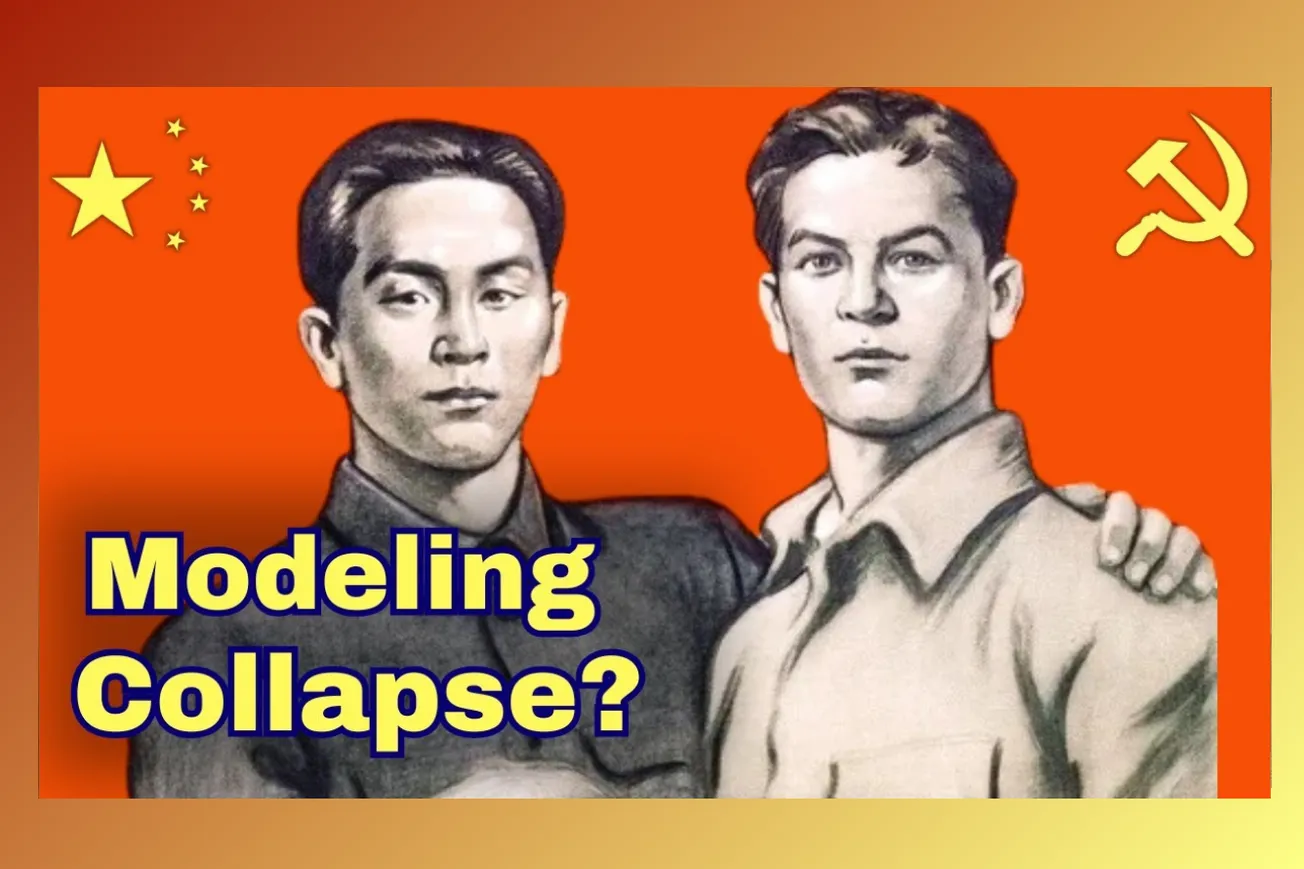Table of Contents
The Chinese Communist Party obsessively studies Soviet history, asking one haunting question: How do you prevent a successful revolution from becoming a failed state? As Xi Jinping reportedly said, "No one was man enough to come out and stand up in defense of the party" when the USSR collapsed. Understanding why the Soviet economic system ultimately failed—despite achieving remarkable early growth—offers crucial insights into China's current challenges with productivity, consumption, and the role of the party-state in a modern economy.
Key Takeaways
- Stalin's planned economy achieved spectacular growth rates but was designed for rapid industrialization, not long-term productivity—a framework that became obsolete as the USSR modernized
- Khrushchev revolutionized Soviet legitimacy by shifting from war mobilization to "peaceful competition" with capitalism, explicitly targeting U.S. living standards as the benchmark for success
- The fundamental distributional problem—over-investment in heavy industry at the expense of consumption—created a vicious cycle where productivity gains couldn't translate into household prosperity
- Brezhnev's "developed socialism" offered stability but institutionalized stagnation, creating a middle-income trap that the party-state couldn't escape without fundamental reform
- Gorbachev's technological optimism—believing the "scientific-technical revolution" could solve economic problems without political change—mirrors Xi Jinping's current faith in AI and digital transformation
- The Soviet internal passport system that created an underclass of migrant workers without social benefits directly inspired China's hukou system
- China today faces strikingly similar distributional challenges but with crucial advantages: export markets for value-added goods and integration into global supply chains
The Stalinist Model: Brilliant and Brutal
Stalin's economic system wasn't just improvised chaos—it was a coherent response to a specific historical moment. The underlying logic was straightforward: if you want to modernize rapidly, you need massive fixed capital investment, which requires high savings rates. Most developing countries go through this process of suppressing consumption to fund industrialization.
What made Stalin's approach unique wasn't the macroeconomic strategy but the genocidal methods used to implement it. The collectivization of agriculture that killed millions of peasants was one particular version of forced savings, not the only possible path to rapid industrialization.
But here's what people forget: the growth rates were genuinely spectacular. By the 1950s and 1960s, economists were seriously discussing whether the Soviet Union would overtake America within a decade or two. This wasn't propaganda—it was based on real economic performance that made the Soviet model attractive to developing countries worldwide.
The system worked because it matched Stalin's worldview about how the world was supposed to function. As Stalin himself explained: "The planned economy is not our wish, it is unavoidable or else everything will collapse. Main task of planning is to ensure the independence of the socialist economy from capitalist encirclement." This was economic policy designed for survival in a hostile imperial system.
The problem was that Stalin's framework assumed a world of competing empires and inevitable wars. When the Cold War evolved into something more complex—American hegemony managing an open trading system rather than closed imperial competition—the Stalinist model lost its strategic purpose.
Khrushchev's Revolutionary Gamble: Peaceful Competition
Khrushchev fundamentally transformed Soviet legitimacy in ways that echo directly in contemporary China. His breakthrough insight was shifting from Stalin's war-mobilization economy to what he explicitly called "peaceful competition" with capitalism. Instead of preparing for inevitable military conflict, the Soviet Union would prove socialism's superiority by achieving higher living standards than capitalist countries.
This represented a massive ideological shift. Under Stalin, comparing Soviet and American living standards was literally forbidden—you could be repressed for making such comparisons. Khrushchev not only encouraged these comparisons but made them central to Soviet legitimacy.
The parallel to Xi Jinping's "systems competition" rhetoric is striking. Both leaders faced the challenge of maintaining revolutionary legitimacy in an increasingly prosperous, urbanized society. Both chose to compete with capitalism on capitalism's own terms—material prosperity and technological advancement.
Khrushchev's approach initially seemed promising. He coupled economic reforms with genuine attempts at international outreach, trying to build a "world socialist system" that countries would want to join voluntarily. The goal was creating an appealing socialist modernity that would trigger crises within capitalism without requiring military confrontation.
But there was a fundamental problem: Khrushchev was a true believer who thought the Soviet system could deliver both rapid investment and rising consumption simultaneously. He doubled down on fixed capital investment while promising abundance, believing pure mobilization could overcome economic trade-offs.
The Distributional Trap: Investment Without Returns
The core economic problem that ultimately destroyed the Soviet Union was what economists call a distributional issue—where resources flow within the system. The USSR consistently channeled resources toward heavy industry and military production at the expense of household consumption.
This created what Polish economist Michał Kalecki (ironically, a dedicated communist) had diagnosed in capitalist economies: a vicious cycle where profits depend on consumption, but consumption depends on wages paid out of profits. Under socialism, the same logic applied—you could invest in many things, but returns only came when someone consumed the output in ways that generated value.
By the mid-1960s, the Soviet Union was investing heavily in assets that weren't creating consumer value. Without adequate household budgets to purchase desired goods, you got cash overhangs and capital assets that had to be written down. It's essentially what Michael Pettis argues about China today: over-investment, under-consumption, and the need for structural rebalancing.
The tragedy is that many Soviet economists understood this problem. During the Kosygin reforms of 1965-1968, there was real possibility for change. Various factions proposed different solutions—price reforms, decentralization, shifting investment priorities. But the political will for fundamental change wasn't there.
Brezhnev's Conservative Consensus: Stability Over Growth
Leonid Brezhnev's genius was political, not economic. He understood that managing the Soviet party-state required creating a consensus that different factions could live with, even if they thought it was suboptimal. His solution was "developed socialism"—essentially arguing that the USSR had achieved 60% of the transition to communism and could coast on that achievement.
The message was simple: we've built a decent middle-income society, you can enjoy reasonable prosperity as long as you don't rock the boat, and technology will eventually solve our remaining problems. No more Stalinist terror, no more Khrushchevian mobilization campaigns—just stable, predictable mediocrity.
This approach worked for maintaining political stability but institutionalized economic stagnation. Growth rates declined, but the system could have "chugged along" indefinitely at a lower level of performance. The problem was that the Soviet Union still saw itself as a global superpower that needed to compete technologically and militarily with the United States.
Brezhnev's solution was technological optimism: the "scientific-technical revolution" would provide productivity shocks that solved economic problems without requiring painful structural reforms. New industries like computing could be introduced through top-down planning, optimizing the economy without disrupting existing arrangements.
Gorbachev's Techno-Optimism and Xi's Echo
Gorbachev inherited this faith in technological solutions but faced the reality that the promised breakthroughs hadn't materialized. His initial response was "acceleration"—doubling down on the scientific-technical revolution through more investment and better political leadership.
This technological optimism directly parallels Xi Jinping's approach to China's current challenges. Both leaders faced productivity stagnation, demographic transitions, and the need to maintain party legitimacy in complex modern societies. Both turned to emerging technologies—Gorbachev to computing and automation, Xi to AI and digital transformation—as solutions that would avoid the need for fundamental structural reforms.
The parallel extends to policy specifics. Gorbachev's anti-alcohol campaign mirrors China's various social control initiatives. Both leaders restructured party-state relationships to increase central control while promising greater efficiency. Both faced the challenge of reforming systems that had succeeded in achieving industrialization but struggled with the next stage of development.
The key difference is timing and external environment. Gorbachev was trying to reform a fully industrialized economy with negative population growth and limited export markets. Xi is working with a country that still has significant development potential and deep integration into global supply chains.
The Institutional Parallel: From Passport to Hukou
One of the most direct institutional borrowings from the Soviet Union to China is the internal migration control system. The USSR's internal passport system created an underclass of migrant workers without access to social benefits in major cities. This cheap labor subsidized Soviet industry while maintaining political control over population movement.
China's hukou system operates on identical principles and was directly inspired by Soviet practices. Like its Soviet predecessor, it creates a large population of workers who can be employed in cities but don't have access to urban social services. This keeps labor costs low while preventing the formation of permanent urban underclasses that might challenge political stability.
Soviet economist Yuri Yarmarko argued in the 1970s that this system was undermining economic development by creating inefficient labor allocation and preventing the spillover effects that should come from high-technology industry. The same critique applies to China today—the hukou system may have served its purpose during rapid industrialization but now constrains productivity growth and domestic consumption.
The Export Market Advantage
The crucial difference between Soviet and Chinese development models is access to export markets for value-added goods. The Soviet Union, partly due to ideological suspicion of trade and partly due to Cold War constraints, never developed significant export industries beyond raw materials.
China's integration into global supply chains provides escape valves that the USSR never had. Even if domestic consumption remains constrained, Chinese manufacturers can sell to global markets. This creates employment, generates foreign exchange, and provides feedback mechanisms for improving productivity.
But this advantage comes with limitations. Export-oriented growth may not create the domestic multiplier effects needed for balanced development. Like Mexico's success in advanced manufacturing or Brazil's aerospace industry, sectoral excellence doesn't automatically translate into broad-based prosperity without structural reforms.
The question facing China is whether export success in industries like EVs and semiconductors will generate sufficient domestic spillovers to overcome distributional problems, or whether they'll create islands of efficiency in an otherwise unbalanced economy.
The Party's Evolving Role
Both the Soviet Union and China faced the challenge of maintaining party relevance as societies modernized. Communist parties served as engines of rapid industrialization, mobilizing resources and disciplining populations during the transition from agricultural to industrial economies. But what role should they play in complex, urbanized societies?
Khrushchev tried to revitalize the party through mass participation campaigns and ideological renewal. Brezhnev essentially turned it into a personnel management system focused on stability rather than transformation. Gorbachev attempted to use political reform to enable economic modernization.
Xi Jinping's approach combines elements of all three predecessors. Like Khrushchev, he's trying to restore ideological commitment and revolutionary spirit. Like Brezhnev, he's using party control to manage elite competition and maintain stability. Like Gorbachev, he believes political centralization can enable economic modernization.
The difference is that Xi has explicitly studied Soviet failures and is trying to avoid what he sees as their key mistakes—particularly allowing the party to become irrelevant to economic management and failing to maintain ideological discipline among cadres.
The Technology Question
Both Soviet and Chinese leaders have turned to technological transformation as a solution to political-economic problems that might otherwise require painful structural reforms. The pattern is remarkably consistent: faced with distributional challenges, productivity stagnation, or international competition, leaders promise that emerging technologies will solve these problems without requiring changes to existing arrangements.
Gorbachev's faith in computing and automation parallels Xi's emphasis on AI, quantum computing, and digital transformation. Both leaders argued that planned economies could deploy new technologies more effectively than market systems because central coordination would enable rational, comprehensive implementation.
The Soviet experience suggests reasons for skepticism about this approach. Technologies develop through complex interactions between users and producers, markets and institutions, that are difficult to replicate through top-down planning. Moreover, technological solutions often require complementary changes in organization, regulation, and social arrangements that may be more disruptive than the original problems they're meant to solve.
Lessons for China's Future
The Soviet experience offers several insights for China's current challenges. First, distributional problems don't solve themselves through growth—they require political decisions about resource allocation that may conflict with existing institutional arrangements and elite interests.
Second, technological optimism can become a substitute for necessary reforms rather than an enabler of them. Believing that AI or automation will solve productivity and consumption problems may delay the structural changes needed to rebalance the economy.
Third, the party-state's role must evolve as societies modernize, but there's no clear template for how to maintain revolutionary legitimacy in prosperous, complex economies. The Soviet failure suggests that gradual reform may be more dangerous than either maintaining the status quo or pursuing rapid transformation.
Fourth, international context matters enormously. China's integration into global markets provides advantages the USSR never had, but it also creates dependencies and vulnerabilities that Soviet leaders never faced.
The Timing Question
Perhaps the most important lesson from Soviet experience is about timing. Many observers argue that if the USSR had pursued major reforms in the 1960s—when it was still growing rapidly and had more flexibility—it might have avoided the later crisis that destroyed the system.
By the 1980s, when Gorbachev finally attempted comprehensive reform, the Soviet Union was a fully industrialized economy with negative population growth, massive capital stock of uncertain value, and limited export options. Any transition was likely to be catastrophic because there was no labor surplus to redeploy and no obvious growth sectors to drive recovery.
China today is more like the Soviet Union of the 1960s than the 1980s—still growing, still with development potential, still integrated into expanding global markets. If structural reforms are necessary, the window for implementing them without catastrophic disruption may be closing as China's economy matures.
The Middle-Income Trap Redux
The Soviet experience illustrates how countries can succeed at achieving middle-income status through forced industrialization but then struggle to transition to high-income, high-productivity economies. The institutional arrangements that enabled rapid capital accumulation—party-state control, suppressed consumption, investment bias toward heavy industry—become obstacles to the next stage of development.
China faces a version of this challenge today. The policies that drove rapid growth over the past four decades may not be optimal for achieving high-income status. But changing those policies requires confronting powerful interests and risking the stability that has underpinned economic success.
The Soviet case suggests that avoiding this transition can work for extended periods—Brezhnev's "developed socialism" provided stability for nearly two decades. But it ultimately leads to stagnation relative to more dynamic economies and creates pressures for reform that may prove more disruptive than gradual change would have been.
Conclusion: History's Lessons and Limits
The Soviet economic experience offers valuable insights for understanding China's current challenges, but historical analogies have limits. China operates in a fundamentally different international environment, with different technological possibilities and different social structures than the USSR ever faced.
What's most relevant may not be specific policy lessons but broader patterns: how distributional problems create political pressures, how technological optimism can substitute for necessary reforms, how party-states struggle to maintain legitimacy as societies modernize, and how timing affects the feasibility of structural change.
Xi Jinping's comment about no one defending the Soviet party when it collapsed reflects a key insight—institutional legitimacy depends not just on performance but on the willingness of elites and populations to support the system when it faces challenges. The Soviet experience suggests that maintaining that support requires more than just delivering growth; it requires adapting institutions to changing circumstances while preserving core sources of legitimacy.
Whether China can navigate this challenge more successfully than the Soviet Union did remains the defining question of 21st-century geopolitics. The answer will depend partly on learning the right lessons from Soviet failures and partly on adapting those lessons to very different contemporary circumstances.





